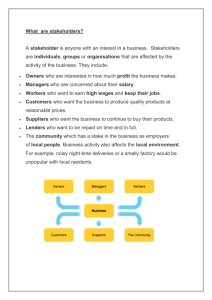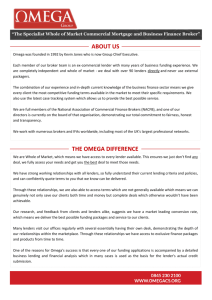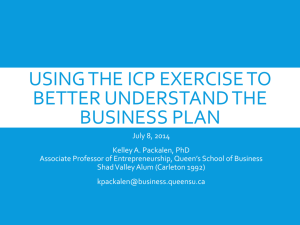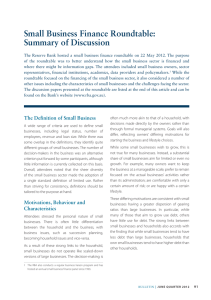3.1 Why a Business Plan Is Important True or False 1. A business
advertisement
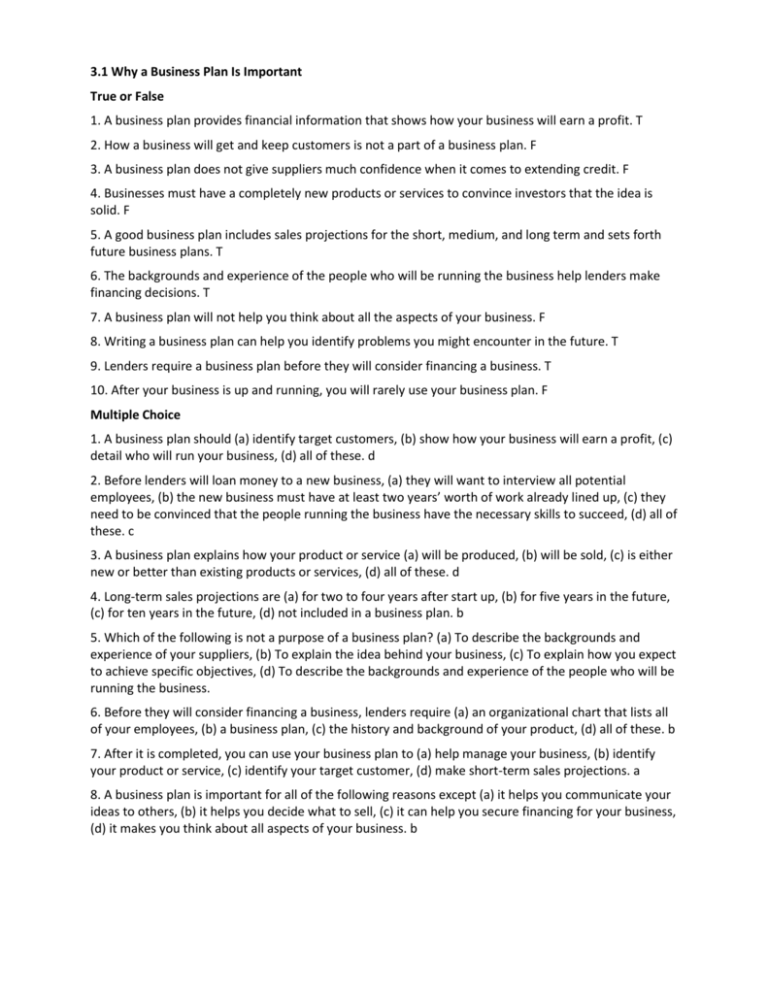
3.1 Why a Business Plan Is Important True or False 1. A business plan provides financial information that shows how your business will earn a profit. T 2. How a business will get and keep customers is not a part of a business plan. F 3. A business plan does not give suppliers much confidence when it comes to extending credit. F 4. Businesses must have a completely new products or services to convince investors that the idea is solid. F 5. A good business plan includes sales projections for the short, medium, and long term and sets forth future business plans. T 6. The backgrounds and experience of the people who will be running the business help lenders make financing decisions. T 7. A business plan will not help you think about all the aspects of your business. F 8. Writing a business plan can help you identify problems you might encounter in the future. T 9. Lenders require a business plan before they will consider financing a business. T 10. After your business is up and running, you will rarely use your business plan. F Multiple Choice 1. A business plan should (a) identify target customers, (b) show how your business will earn a profit, (c) detail who will run your business, (d) all of these. d 2. Before lenders will loan money to a new business, (a) they will want to interview all potential employees, (b) the new business must have at least two years’ worth of work already lined up, (c) they need to be convinced that the people running the business have the necessary skills to succeed, (d) all of these. c 3. A business plan explains how your product or service (a) will be produced, (b) will be sold, (c) is either new or better than existing products or services, (d) all of these. d 4. Long-term sales projections are (a) for two to four years after start up, (b) for five years in the future, (c) for ten years in the future, (d) not included in a business plan. b 5. Which of the following is not a purpose of a business plan? (a) To describe the backgrounds and experience of your suppliers, (b) To explain the idea behind your business, (c) To explain how you expect to achieve specific objectives, (d) To describe the backgrounds and experience of the people who will be running the business. 6. Before they will consider financing a business, lenders require (a) an organizational chart that lists all of your employees, (b) a business plan, (c) the history and background of your product, (d) all of these. b 7. After it is completed, you can use your business plan to (a) help manage your business, (b) identify your product or service, (c) identify your target customer, (d) make short-term sales projections. a 8. A business plan is important for all of the following reasons except (a) it helps you communicate your ideas to others, (b) it helps you decide what to sell, (c) it can help you secure financing for your business, (d) it makes you think about all aspects of your business. b 3.2 What Goes Into a Business Plan? True or False 1. All business plans have different purposes, so they do not all have the same basic elements. T 2. Describing how you came up with the idea for your business can help others understand how your business will operate. T 3. Writing a business plan can force entrepreneurs to think about their goals. T 4. A handwritten business plan is acceptable if it is neat, well organized, and inviting to read. F 5. Only corporations need to include a form of ownership section in a business plan. F 6. Copies of resumes help show that owners are qualified to manage a business. T 7. The marketing section of your business plan should describe the location of your business. T 8. A financial statement based on projected revenues is called an informal financial statement. F 9. The financial section of your business plan should state how much money you need to borrow and how much you are investing in the business. T 10. A brief explanation of why you are asking for a loan and what you plan to do with themoney is called an executive summary. F Multiple Choice 1. The introduction section of a business plan contains all of the following except (a) a description of the business and its goals, (b) the legal structure of the business, (c) an identification of risks, (d) the advantages your business has over your competitors. c 2. Information about necessary equipment for your business is included in the (a) financial management section, (b) concluding statement, (c) marketing section, (d) operations section. d 3. Your business plan should describe the location of your business because (a) different forms of ownership have different types of locations, (b) every industry has an ideal type of location, (c) location is often a critical factor in a business’s success, (d) all of these. c 4. The marketing section of your plan explains (a) how you plan to enter the market, (b) who your prospective customers are, (c) your advantages over the competition, (d) all of these. d 5. In the financial management section, a new business must include (a) projected financial statements, (b) copies of all rental agreements, (c) current financial statements, (d) all of these. a 6. Which of the following is not an element of the financial management section of your plan? (a) Identification of risks, (b) Distribution of profits and losses, (c) Financial statements, (d) Funding request and return on investment. b 7. A letter that introduces and explains an accompanying document is called a(n) (a) cover letter, (b) introductory letter, (c) statement of purpose, (d) letter of intent. a 8. An executive summary (a) should be written before the business plan is completed, (b) includes supporting documents that back up statements made in the body of the report, (c) state the amount you want to borrow, (d) must never be longer than two paragraphs. c 9. A business plan’s title page includes all of the following except (a) a summary of the plan, (b) the name of your company, (c) the date, (d) the owner’s name. a 10. The appendix of a business plan might include (a) tax returns of the business owner, (b) letters of recommendation, (c) a copy of required licenses, (d) all of these. d Problem Solving 1. In the marketing section of your business plan, you need to provide information in four areas. a. What information should be included about your products or services? The section should describe the products or services the business plans to produce and sell, explain how they differ from those already on the market, highlight any unique features, and explain the benefits customers will receive by purchasing from the business. b. What information should be included about your market? This section will explain who your prospective customers are, how large the market is for your product or service, how you plan to enter that market, and how you plan to deal with competition. c. What information should be included about the industry you will operate in? The industry section should include the growth potential and economic trends of the industry; technology that may affect the industry; forecasts for industry growth; and external factors that can affect the business, such as high competition or lack of suppliers. d. How might the location of your business affect its success? If the business is located too close to competing businesses, sales may suffer. If the business is located too far from the target customer or if parking is not available, people may not go there because they consider it inconvenient. 2. The financial management section of your business plan consists of three elements. List these elements, describe what is included in each, and explain why the information is necessary. Identification of risks: This section should list the problems that could cause your business to lose sales and your plans to deal with the problems. Prospective lenders know that every business faces risks and will be reassured to see that you have considered these risks and have devised plans to deal with them. Financial statements: This section should include current and/or projected financial statements. Prospective lenders want to know what you expect to earn in revenues and to pay in expenses. They can then analyze your figures to be sure they are reasonable. Funding request and return on investment: This section should include how much money you are investing in the business, how much you need to borrow, and how you plan to use the money. Prospective lenders want to know whether the total amount of money involved will be sufficient and whether it will be used wisely. Investors want to know how much money they can expect to earn on their investment. 3.3 How to Create an Effective Business Plan True or False 1. To convince readers that you have a practical business plan, you must include information and data from objective sources. T 2. Writing an effective business plan should only take 24 hours. F 3. Counselors from Small Business Development Centers and volunteers from SCORE can provide advice and workshops to help you develop your business plan. T 4. Entrepreneurs can hire experts from trade associations to help them prepare business plans. F 5. The Internet is not a trusted source of information on how to develop a business plan. F 6. A local Chamber of Commerce can provide information on trends affecting local 6.Tbusinesses, local resources, and zoning and licensing information. 7. Entrepreneurs should avoid seeking advice from bankers or accountants because doing so will make them appear inexperienced and unqualified to run a business. F 8. An undefined target market can ruin a business plan. T 9. Never reveal your competitors’ strengths in your business plan—focus only on what they are doing wrong. F 10. The only person who should read a business plan is the owner and potential investors. F Multiple Choice 1. Assistance from an SBDC is available to (a) anyone who cannot afford the services of a private consultant, (b) existing business owners only,(c) first-time business owners only, (d) minority business owners only. a 2. The retired executives at SCORE (a) provide advice for a small fee, (b) hold inexpensive workshops, (c) represent all areas of business, (d) have offices at the SBA. c 3. Which of the following is an independent agency of the federal government that helps Americans start, build, and grow businesses? (a) SCORE, (b) the SBA, (c) local Chambers of Commerce, (d) all of these. b 4. Trade associations provide all of the following to entrepreneurs except (a) useful information, (b) education, (c) networking opportunities, (d) small loans. d 5. Which of the following is least likely to be a helpful resource for your business plan? (a) National Geographic, (b) books on entrepreneurship, (c) SBA publications, (d) BusinessWeek magazine. a 6. Online business resources (a) should not be used in a business plan, (b) are not as reliable as print resources, (c) can be found via search engines, (d) are not available from the SBA. c 1. 7.Financial projections in a business plan should be (a) left out of your business plan if you could not locate reliable financial information, (b) based on solid evidence, (c) very optimistic, in order to impress investors, (d) based on your best guess. b 7. Your business plan must (a) clearly define your market, (b) never overlook the competition, (c) be consistent, (d) all of these. d


